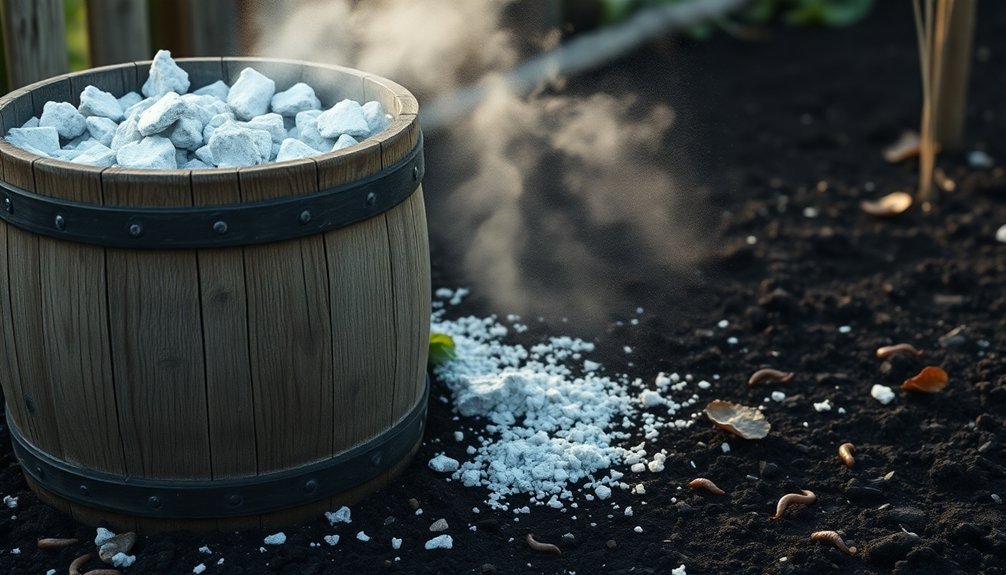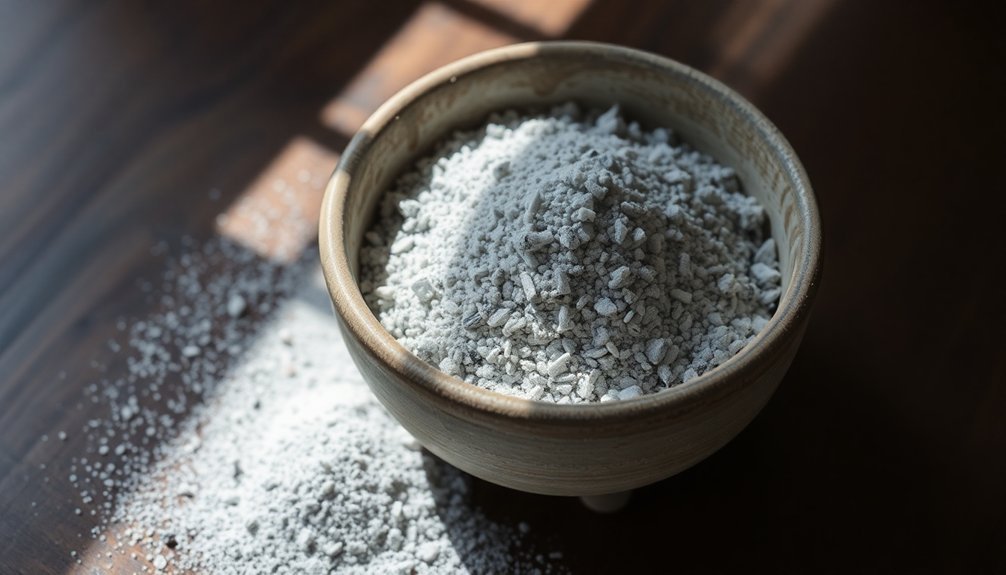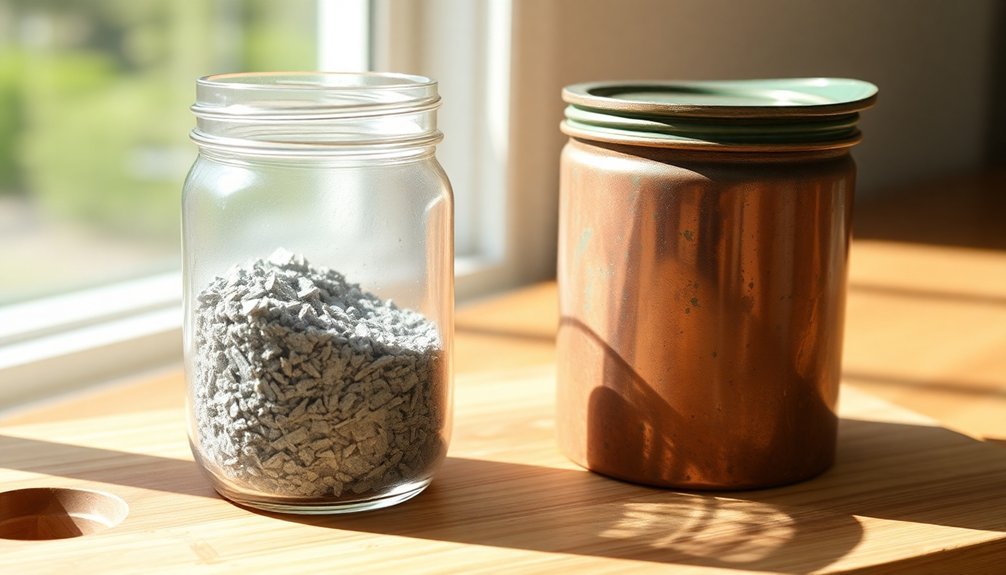Wood ash preservation can effectively extend your food's shelf life through its natural compounds, including calcium (7-33%) and potassium (3-10%). When you properly apply sifted ash, it creates an alkaline environment that inhibits harmful bacteria and absorbs excess moisture. You'll find it particularly effective for preserving tomatoes, eggs, and hard cheeses, with storage times ranging from three months to a year. However, you'll need to handle wood ash carefully, as it can contain heavy metals and cause respiratory issues if inhaled. Using protective gear and selecting ash from untreated wood sources will help you maximize its benefits while minimizing potential risks. The centuries-old wisdom behind this preservation method holds many more secrets to explore.
What Makes Wood Ash Effective

Three key properties make wood ash an effective food preservation agent: its chemical composition, alkaline nature, and physical structure.
The chemical makeup includes high levels of calcium (10-25%), potassium (5-15%), and other minerals that create an environment where harmful microorganisms can't thrive. These minerals work together to help maintain food quality while preventing spoilage. A study demonstrated that tomato decay dropped to just 20% when treated with 1.5 kg of wood ash.
The ash's highly alkaline properties create conditions that most decay-causing organisms can't tolerate. When you're using wood ash for preservation, you'll benefit from its ability to neutralize acids and create an inhospitable setting for bacteria and fungi.
It's particularly effective when you use hardwood ash, which provides up to five times more nutrients than softwood ash.
The physical structure of wood ash also plays an essential role in food preservation. Its lightweight, porous nature helps absorb excess moisture that could lead to spoilage.
You'll find small pieces of charcoal and bio-char in the ash that increase airflow around stored foods. Additionally, the ash's abrasive quality repels pests like insects that might damage stored food, though this protection diminishes if the ash gets wet.
Storage Time and Shelf Life
You'll find that different foods have varying storage durations when preserved in wood ash, ranging from six weeks for tomatoes to nearly a year for eggs.
The average temperature at 80.55°F and high humidity can significantly impact preservation effectiveness, making proper storage conditions crucial for optimal results.
Your success with wood ash preservation depends on critical factors like the type of ash used, the ripeness of the food, and proper storage conditions such as temperature and humidity.
To maximize shelf life, you need to guarantee complete coverage of food items with sifted wood ash and maintain proper storage in a cool, dry environment.
Storage Duration Guidelines
Understanding food storage duration in wood ash requires careful attention to the specific type of food being preserved. You'll find that different foods have varying preservation times, with some lasting considerably longer than others when properly stored in wood ash.
| Food Type | Storage Duration | Special Requirements |
|---|---|---|
| Tomatoes | 5-6 months | 1.5kg ash per 1kg tomatoes |
| Hard Cheese | 3+ months | Must be hard variety only |
| Meat | Several months | Requires cool, dark storage |
| Eggs | Not recommended | Use lime solution instead |
| Fresh Produce | Varies by type | Must be properly layered |
For ideal storage duration, you'll need to maintain proper conditions. Store your preserved foods in a cool, dark location, preferably in a basement or underground storage area. Use earthenware crockery or sealed containers, and make sure you're using finely sifted ash free from large charcoal pieces.
You should monitor your stored items regularly for signs of spoilage. When preserving tomatoes, you'll get the best results using the recommended ratio of 1.5 kg ash per 1 kg of tomatoes. For cheese preservation, stick to hard varieties only, as soft cheeses won't store well due to their moisture content. Using hardwood ash for preservation is recommended as it produces better results than ash from softwoods like pine, which can contain resins that affect food taste.
Factors Affecting Shelf Life
Preserving food with wood ash requires careful attention to both intrinsic and extrinsic factors that influence shelf life. When you're storing items like tomatoes and potatoes, wood ash's moisture-absorbing properties help create an ideal environment by reducing humidity and preventing decay.
The ash's alkaline nature also works to inhibit fungi and pathogens that typically cause food spoilage. You'll need to maintain proper temperature control, as cool conditions are essential for maximizing wood ash's preservation effects.
It's important to use well-sealed containers and properly sifted ash to create an effective storage medium. The ash's natural preservative properties often eliminate the need for additional chemical treatments.
When you compare wood ash to other storage methods, you'll find it performs particularly well in moisture control and pest prevention. While it doesn't greatly affect the sugar or nutrient content of stored foods, it helps maintain their quality by controlling environmental factors.
The ash effectively slows down deterioration by absorbing excess moisture and creating an alkaline environment that's hostile to many pathogens. This method has proven especially effective for root crops like potatoes, showing better results than traditional methods such as rice straw storage.
Optimal Preservation Periods
The ideal preservation periods for wood ash storage vary considerably across different food types and storage conditions. You'll find that hard cheeses with low moisture content can maintain quality for at least three months, while tomatoes treated with the right ash ratio can stay fresh for up to four weeks. For best results with tomatoes, you'll need to use 1.5 kg of ash per 1 kg of produce, which can reduce decay rates to as low as 20%.
| Food Type | Storage Period | Key Requirements |
|---|---|---|
| Hard Cheese | 3+ months | Cool, dark storage; low moisture content |
| Tomatoes | Up to 4 weeks | 1.5:1 ash-to-tomato ratio |
| Meat | Several months+ | Complete ash coverage; cool storage |
When preserving meat, you'll want to follow the Cherokee method of using hickory ash, which not only preserves but also adds flavor to the meat. For all preservation methods, you'll need to verify your storage containers protect food from air exposure and keep items separated. Whether you're using earthenware crocks or cardboard boxes, maintaining cool, dark conditions is essential for maximizing preservation periods. Remember that each food item must be completely surrounded by ash without touching other pieces.
Traditional Preservation Methods

Throughout history, several traditional methods have made wood ash preservation a reliable way to store food. You'll find that hard cheeses and tomatoes are particularly well-suited for this preservation technique, though they require different approaches.
For cheese preservation, you'll need a stoneware pot or earthenware crock with a lid. Place your hard cheese, such as Gruyere, in the container and surround it with 1 to 1.5 inches of sifted wood ash on all sides. The ash will create a protective rind, keeping your cheese fresh for up to three months when stored in a cool, dark place.
When preserving tomatoes, you can use wooden containers, cardboard boxes, or woven baskets lined with paper. Start by spreading a 1.5-inch layer of sifted ash, then arrange ripe, unblemished tomatoes upside down.
Continue alternating layers of tomatoes and ash until your container is full. While the tomatoes' skin will wrinkle during storage, the pulp remains juicy. This method, discovered by observing tomatoes near ash-covered banana trees, has proven especially valuable in regions where tomatoes become scarce during certain months.
Health Concerns and Safety
Working with wood ash requires careful attention to significant health risks. When you're using wood ash for food preservation, you'll need to protect yourself from multiple exposure routes that can cause serious health issues. Inhaling wood ash can lead to respiratory problems, lung cancer, and even damage to your central nervous system through ultrafine particles that enter your bloodstream.
You must avoid direct skin contact with wood ash, as it can cause irritation, chemical burns, and chronic skin conditions, especially when mixed with moisture. Your eyes are particularly vulnerable, so proper eye protection is essential.
If you're handling food preserved with wood ash, you'll need to be aware of potential contamination from heavy metals like arsenic, lead, and mercury, which can be present even in small amounts. You should be especially cautious if you have children around, as they're more susceptible to cognitive problems from lead exposure.
When working with wood ash, always wear appropriate protective gear, including respiratory protection that meets OSHA standards, impervious gloves, and eye protection. Ascertain proper ventilation in your work area and thoroughly wash any food items before consumption.
Environmental Impact of Wood Ash

When you dispose of wood ash, you'll need to contemplate its significant effects on soil chemistry and water quality, as it can dramatically alter pH levels and nutrient concentrations.
You must store wood ash properly indoors or in secure outdoor containers to prevent toxic run-off from reaching surface or ground water.
If you're planning to use wood ash for land application, you'll want to carefully assess your soil's pH first, since excessive alkalinity can harm plant growth and disrupt soil bacterial communities.
Soil and Water Effects
The environmental impact of wood ash on soil and water systems reveals both promising benefits and potential risks. When you're using wood ash, you'll find it can markedly improve soil fertility through its rich content of calcium, potassium, magnesium, phosphorus, and sulfur.
It's particularly effective at raising soil pH, making it valuable for acidic soils that need correction. You'll notice improved water retention and infiltration in your soil after applying wood ash, which is essential during drought periods. This enhancement means you won't need to water as frequently, and your plants will have better access to moisture when they need it most.
However, you'll need to be cautious about application rates, as wood ash can pose environmental risks if not used properly. If you're not careful, you could introduce heavy metals like zinc and cadmium into your soil, especially if you're using ash from low-quality wood sources.
You'll want to avoid ash from treated timber completely, as it can contain harmful residues. The ash's high alkalinity can damage your crops if over-applied, and there's potential for runoff to affect nearby water bodies, altering their chemical composition.
Safe Disposal Methods
Safe disposal of wood ash requires several essential precautions to protect both your health and the environment.
You'll need to wait 24 to 48 hours for ashes to cool completely before handling them to prevent re-ignition, as hot embers can remain active for several days.
When you're ready to dispose of the ash, use a metal container with an airtight lid, and never use plastic containers that could melt.
Always wear protective gear, including gloves, a mask, and eye protection when handling ash, as it contains harmful substances like arsenic, cadmium, chromium, and mercury.
You'll want to store your ash container at least three feet away from flammable materials in a cool, dry area.
Don't place ash storage near wells, surface water, or animal watering areas to prevent contamination.
If you're considering recycling options, you can use cooled ash as fertilizer or add it to compost piles.
However, don't use ash from treated wood, as it poses environmental risks.
Before disposing of ash in regular trash, check your local regulations first, as some areas have specific requirements for wood ash disposal.
Proper Handling Guidelines
Proper handling of wood ash requires careful attention to both safety and effectiveness when preserving food.
You'll need to start by selecting ash from natural, untreated wood sources while avoiding any ash from treated materials, waste oil, plastics, or garbage. Before use, sift the ash carefully to remove charcoal pieces and verify there are no active embers or sharp particles.
When storing your preserved food, choose appropriate containers like earthenware crockery or wooden boxes lined with paper. You'll want to layer the food items carefully with ash, making sure they don't touch each other or the container walls.
While the container should be covered, it shouldn't be completely airtight – this allows for necessary air circulation while preventing moisture buildup.
You'll need to monitor your stored items regularly for signs of spoilage or pest damage. Keep your storage area consistently cool and dark to maintain the ash's preservative properties.
Remember that wood ash is highly alkaline, so you should handle it with care and avoid getting it wet, as moisture can reduce its effectiveness and leach nutrients. If you're concerned about contamination, consider testing the ash for heavy metals before use.
Best Foods for Ash Preservation

After mastering proper handling techniques, you'll want to focus on selecting the right foods for ash preservation. While several foods can be preserved using wood ash, tomatoes and eggs stand out as the most well-documented success stories.
You'll find that tomatoes can last up to six months when properly stored in wood ash. Select ripe but firm tomatoes without blemishes or bruises – the ash will help maintain their juice and texture while preventing bacterial growth.
Similarly, you can preserve eggs for nearly a year using this method by simply placing them in a pot filled with wood ash.
If you're interested in preserving other foods, peppers respond well to ash preservation, similar to tomatoes. You can also use wood ash to preserve grains, taking advantage of its moisture-absorbing and antibacterial properties.
While it's possible to preserve meat using wood ash, this method isn't as widely documented.
Remember that not all foods are suitable for ash preservation. Root vegetables and legumes benefit from wood ash in gardening but aren't typically preserved this way.
There's also limited evidence supporting ash preservation for dairy products.
Cost and Resource Efficiency
Frugal food preservers will appreciate wood ash's remarkable cost efficiency and widespread availability. If you're using a wood stove or traditional cookstove, you're already generating this valuable resource at no extra cost. A single cord of wood can produce about 20 pounds of ash, providing ample material for both food preservation and soil amendment needs.
You'll find wood ash particularly accessible in regions where wood is the primary fuel source, especially in sub-Saharan Africa, where 70% of the population uses traditional cookstoves. The preservation process itself doesn't require special equipment or extensive training, making it an economically viable option for smallholder farmers.
Key benefits of wood ash preservation include:
- Zero additional costs for purchasing commercial preservatives
- No need for specialized equipment or technology
- Can double as a soil amendment, reducing fertilizer expenses
- Easily integrated into existing farm labor routines
- Readily available storage options using basic containers
You'll also appreciate that this traditional method leverages existing resources and knowledge passed down through generations, ensuring that implementation remains straightforward and cost-effective.
The dual-purpose nature of wood ash as both a preservative and soil amendment further enhances its economic value.
Chemical Properties of Wood Ash

The chemical composition of wood ash reveals a complex mixture of elements and compounds that contribute to its preservative properties. You'll find significant amounts of calcium, making up 7% to 33% of the ash, primarily in the form of calcium carbonate (CaCO3), which accounts for 25% to 45% of the total ash weight. This high calcium content helps create an alkaline environment that inhibits microbial growth.
When you examine the other major components, you'll notice potassium (3-10%) and carbon (5-30%), along with essential minerals like magnesium and phosphorus in smaller quantities. The presence of silicon dioxide (4-60%) and aluminum oxide (5-20%) adds to the ash's structural stability.
You'll also find trace elements such as iron, manganese, zinc, and copper, which can affect food preservation qualities.
It's important to understand that wood ash's chemical reactivity is notable, as it readily reacts with calcium hydroxide at normal temperatures. The ash's high alkali content (exceeding 1.5%) and varying loss on ignition (0.1-33%) influence its interaction with food.
However, you should be aware that heavy metals like lead, cadmium, nickel, and chromium can be present in varying concentrations.
Nutritional Effects on Food
Wood ash's high mineral content, particularly its potassium and calcium levels, can boost your food's nutritional value while helping maintain ideal pH balance during storage.
You'll notice changes in food texture and density when using wood ash, as it creates a protective barrier that helps preserve firmness and reduces moisture loss.
The ash's rich composition of essential minerals like iron, zinc, and magnesium can enhance your food's overall nutrient profile, though you'll want to use only clean, untreated wood ash to avoid potential toxins.
Ph Balance and Nutrients
Understanding pH balance proves critical when using ash for food preservation, as its highly alkaline nature (pH 10-12) directly impacts nutrient availability and bacterial activity. When you're using wood ash, you'll need to take into account how its powerful pH-altering properties affect both the food and any bacteria present.
The nutrient composition of wood ash plays a significant role in preservation effectiveness. You'll find it's rich in potassium (5-7%), calcium, and magnesium, while also containing trace amounts of essential micronutrients. However, it's essential to mention that ash lacks nitrogen, which burns off during combustion.
- Wood ash rapidly increases pH levels, creating an environment where many harmful bacteria can't thrive.
- Its high mineral content, particularly potassium, helps draw moisture out of food.
- You'll need to apply ash carefully, as excessive amounts can create extreme alkalinity.
- The preservation effects vary based on the type of wood burned and burning conditions.
- Using ash from untreated wood sources guarantees you avoid contaminating your food with heavy metals.
To maintain proper nutrient balance, you should monitor application rates and think about mixing ash with other preservation methods for best results.
Texture and Density Changes
Physical changes in food texture and density occur gradually when using wood ash preservation, with noticeable effects on firmness, weight, and structural integrity. While you'll notice that ash treatment can't completely prevent texture degradation, it greatly slows down the process and helps maintain your food's physical structure longer than untreated items.
You'll find that proper ash coverage is essential for preserving density and controlling moisture levels. When you're storing tomatoes, for example, you'll need to guarantee complete ash coverage, with approximately 1.5 kg of ash per kg of tomatoes for the best results.
Though you'll still observe some firmness reduction and weight loss over time, these changes will be less dramatic than in untreated food.
For best results, you'll want to store your ash-preserved food in cool, dark conditions using earthenware crockery or cardboard boxes. When you maintain consistent storage conditions and proper ash coverage, you're creating an effective barrier against microbial growth, moisture damage, and pest infestation.
While you can't completely prevent natural density and texture changes, proper ash treatment will greatly extend your food's shelf life and maintain its usability.
Mineral Content Impact
Mineral interactions between wood ash and stored food regularly influence the nutritional content of preserved items. When you're using wood ash for food preservation, you'll need to take into account how its high calcium content (7-33%) and potassium levels (3-10%) can affect your stored foods. These minerals often migrate into the preserved items, potentially altering their nutritional profile.
The mineral content impact varies depending on several key factors:
- Calcium from the ash can increase the calcium content of your stored foods, particularly in high-moisture items.
- Potassium transfer may enhance the mineral content of preserved foods, though it's influenced by storage conditions.
- Phosphorus and magnesium, present in smaller amounts, can contribute to subtle nutritional changes.
- Micronutrients like zinc and copper might transfer in trace amounts.
- Heavy metal presence requires careful monitoring to prevent contamination.
You'll find that different food types interact uniquely with wood ash minerals. Dense, dry foods typically experience less mineral transfer than moist ones.
The high pH of wood ash, primarily due to its calcium content, creates an alkaline environment that not only preserves but can also modify the food's mineral composition during storage.
Storage Container Options

When preserving food with wood ash, selecting the right storage container plays a crucial role in the success of your preservation efforts. Earthenware crockery stands out as your most reliable option, offering non-reactive properties and exceptional durability.
You'll find these containers particularly effective when sealed with stoneware lids, creating an ideal environment for preserving cheese, meat, and various produce.
If you don't have access to earthenware, you can use cardboard boxes as an alternative. Just remember to line them with paper to prevent direct contact between your food and the ash.
While cardboard containers work well for items like tomatoes, they won't last as long as earthenware.
For a traditional approach, you might consider creating storage holes in the ground. This method provides naturally cool, dark conditions that support long-term preservation.
You'll need to carefully prepare the hole by lining it and ensuring proper sealing to keep out moisture and air.
Regardless of your container choice, always sift the wood ash to remove debris, spread it evenly, and maintain consistent layering.
Keep your storage containers in a cool, dry place away from direct sunlight to maximize preservation effectiveness.
Historical Preservation Practices
Ancient civilizations discovered the remarkable power of wood ash preservation, a technique that continues to influence food storage practices today.
You'll find evidence of this method across various cultures, from the Cherokee people using hickory ash for meat preservation to African farmers extending the shelf life of their tomatoes.
The historical significance of wood ash preservation is demonstrated through these time-tested practices:
- Cherokee communities preserved and flavored meat using hickory ash, showing the dual benefits of this method.
- African farmers developed techniques to store tomatoes in wood ash for up to six months.
- Traditional societies discovered that eggs could be preserved for nearly a year using wood ash.
- Various cultures adapted the method for preserving hard cheeses, grains, and other staples.
- Different regions developed specific wood ash preferences based on local tree species.
You'll notice that these preservation techniques share common principles across cultures.
The method always involves carefully sifted, cooled ash layered with food items in a controlled environment.
This traditional knowledge has proven so effective that some communities still rely on wood ash preservation, particularly in regions where modern storage methods aren't readily available.
Frequently Asked Questions
Can Wood Ash From BBQ Grills Be Used for Food Preservation?
You can use BBQ grill wood ash for food preservation if it's from clean hardwoods only. Be careful to avoid ash from treated wood or contaminated sources, as they'll contain harmful heavy metals.
Does Burning Different Types of Wood Affect Preservation Effectiveness?
Yes, different woods affect preservation effectiveness. You'll find varying pH levels and mineral contents in different wood ashes, which impacts their preservative power. It's best to use ash from natural, untreated hardwoods.
How Do You Know When Ash-Preserved Food Has Gone Bad?
You'll know ash-preserved food has spoiled if you notice mold growth, unusual discoloration, slimy texture, foul odors, or any significant texture changes. Always check for off-putting smells and visual abnormalities before consuming.
Can Wood Ash Preservation Be Combined With Other Preservation Methods?
Yes, you can combine wood ash preservation with other methods like cold storage, proper container sealing, and pre-washing treatments. This multi-layered approach will help you achieve better preservation results and longer storage life.
Does the Age of Wood Ash Affect Its Preservation Capabilities?
Yes, the age of your wood ash does matter. You'll get better preservation results with fresh ash since older ash can lose potency and absorb moisture over time, reducing its effectiveness as a preservative.
In Summary
Wood ash preservation offers you both advantages and risks for food storage. While you'll benefit from its natural preservative properties and traditional roots, you need to carefully consider safety protocols and potential health impacts. Before using wood ash, verify you're selecting appropriate containers and following proper handling methods. You'll want to weigh environmental factors and nutritional effects against modern preservation alternatives for your specific storage needs.





Leave a Reply